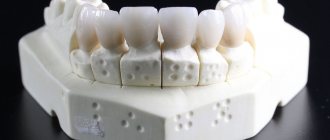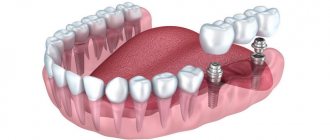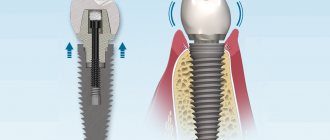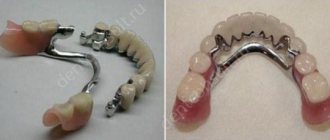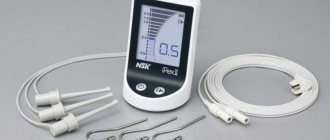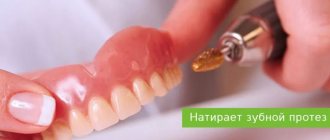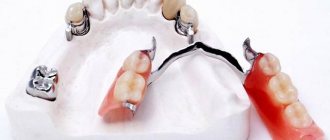August 23, 2019
The trend is that today an increasing number of patients, after losing one or more teeth, resort to high-quality implantation methods. However, some still prefer prosthetics with bridge structures, which are cheaper. But did you know that bridges are also different? Have you heard anything about the most mysterious of them - adhesive bridges in dentistry? If not, read the article by the editors of the UltraSmile.ru portal. You will find a lot of useful information on this topic.
Indications for use
All types of prostheses have a list of recommendations for installation. Indications for the use of an adhesive bridge include:
- Missing several teeth in front or defects of premolars. In this case, the adjacent teeth must be in good condition.
- When the patient’s health does not allow conventional prosthetics.
- In cases requiring urgent elimination of a defect in the oral cavity.
- For diseases such as myocardial infarction, cardiovascular diseases or periodontal disease.
- As a temporary installation if implantation is carried out in two stages.
In this case, the age of the patient should be taken into account; dentists do not recommend this type of prosthesis for older people .
It will not be possible to install an adhesive bridge if the neighboring teeth are in poor condition and pathological abrasion of the enamel is observed. With an abnormal bite, it is impossible to properly secure the structure.
What is fixed prosthetics?
Fixed prosthetics involves implanting an artificial root into the bone tissue where teeth are missing. Subsequently, a prosthesis is installed on the root. The patient will not be able to remove the structure on his own. There is another method of restoring the dentition - using removable structures. But it has disadvantages, so it is mainly used only if the patient is not suitable for fixed dentures.
Differences in dentures
Advantages
An adhesive bridge has a number of advantages. Let us note the main ones:
- Adhesive technology involves the restoration of some defects of premolars, incisors and canines directly in the patient’s oral cavity.
- While wearing such a prosthesis, there is no destruction of the teeth that act as supporting ones.
- Speed of the procedure. In one session, a complete restoration of an incisor or canine can be performed.
- Before installing the product, the impact on the supporting teeth is minimal. They are only slightly ground, depulpation is not carried out.
- The design is one of a number of highly aesthetic products that do not contain metal. Thanks to this solution, oxidation does not occur, which has a harmful effect on the human body. The formation of galvanic vapors is also excluded.
- When compared with metal-ceramic structures or implants, an adhesive bridge is a budget option.
What is curettage of periodontal pockets? Read our review.
This article will tell you what to do if a molar tooth is loose.
Here: https://www.vash-dentist.ru/lechenie/desnyi/parodontoz/sposobyi-narodnyimi-sredstvami.html - you will learn about the treatment of periodontal disease with folk remedies.
Video about the advantages of adhesive bridges:
Fact #1: There is no need to grind your teeth for adhesive bridges.
An adhesive bridge, just like a classic one, is most often placed when one tooth is missing. It rests on neighboring units located on either side of the lost one. However, compared to the classic design, which consists of three crowns, the adhesive apparatus looks different: it has only one crown and plates extending from it, which look like “wings”. In this case, these same plates will be attached to the supporting teeth. But to install them, there is no need at all to grind and prepare the supports, change their appearance beyond recognition and remove the nerve - as this has to be done before installing classic bridges. It will be enough to make small ledges on the supporting units (on their lateral or palatal surface - from the side of the tongue) and use dental glue.
When installing such dentures, adjacent teeth are not ground down
Adhesive structures, like any other dentures, cannot be installed during bruxism, inflammation of periodontal tissues and the presence of severely loose or destroyed supporting teeth.
The absence of the need to prepare hard tissues and depulpate the tooth is a plus, because The installation procedure for such structures does not require invasive intervention and is painless. In addition, thanks to this approach, the supporting teeth take on minimal load and do not wear out as much as compared to those under classic traditional bridges consisting of three artificial crowns. Another advantage: their processing process is reversible; when the adhesive structure is removed, holes and ledges in the supports can be easily masked with composite material.
Flaws
Despite all its advantages, this design is temporary. It will be relevant if you need to hide minor defects. Over time, the bridge collapses and chips appear. It is susceptible to abrasion and breakage .
The use is limited, since the bridge is mainly suitable for those who need to correct a defect in the front tooth. At the same time, the product is created in such a way that it does not load the bone. As a result, atrophy of the alveolar process occurs. This may lead to the need for bone grafting when installing implants.
Also, the disadvantages of the prosthesis include the following points:
- difficulties in carrying out daily oral hygiene;
- serious load on supporting teeth;
- risk of secondary caries formation at the bridge attachment sites.
Low service life
Negative factors when using an adhesive bridge include the short service life of the prosthesis (about 4-5 years). Dental clinics provide a guarantee of 3 years. But if you treat it with care, the period doubles.
To wear a prosthesis for 10 years, you must follow your doctor's recommendations.
Dentists recommend using this product as a temporary installation, which is suitable for teeth that do not perform a chewing function.
Which fixed dentures to choose
Microprosthetics with veneers are recommended for restoration of the smile area. These are modern techniques that allow you to achieve aesthetics. In addition, they are not colored with food coloring.
In case of partial absence of teeth, implants or bridge types of prostheses are used. The best option is implantation of All on 4 or All on 6. They are characterized by a long service life and a good aesthetic effect. Bridge structures are suitable for installation directly on the upper and lower jaw.
Care
To increase the service life of the prosthesis, it is necessary to follow the rules of care for it and the oral cavity. They are simple and become a habit over time:
- Regular cleaning of teeth and dentures with good toothpaste. It is advisable to carry out after each meal, the goal is to prevent the accumulation of food debris in the prosthesis area. If this is not possible, rinse your mouth.
- regular professional hygiene. Minimum – once every six months, ideally – every 3 months.
- timely treatment of abutment teeth. You need to examine them yourself and if you find caries or problems with the gums, contact your dentist.
- refusal of hard foods. In order to extend the service life of the bridge, it will be necessary to minimize any processes that contribute to its failure.
It is not advisable to use floss in the denture area.
By following these rules, the patient keeps the prosthesis in working condition and delays the replacement period.
Fact #4: Wearing bridges can cause tooth decay.
When installing a bridge, the dentist glues its wings to the surface and ledges made in the supporting teeth. The design itself seems simple, but caring for teeth in the area where the plates are located is not so easy. If the plates are not glued very well, then pieces of food and bacteria can get clogged under them, which will provoke inflammation and cause the development of caries.
“I wore such a bridge, I can say that at first it really seems quite beautiful, and its price is even more pleasing, and plus there is no need to depulpate the teeth. BUT, after 1-2 years the beauty of the smile deteriorates sharply, it seems that the bridge is not adjacent to the gum, but is simply dangling in the air, i.e. a distance appears between it and the gum. And this is inevitable, the doctor told me that it is bone atrophy that leads to this effect. Only an implant will save you from atrophy. And girls, in the end I spent 8 thousand on the bridge, and then 30 thousand on the implant. Now I understand that these bridges do not even delay the costs of treatment, but only increase them even more!”
Margot, review from otzovik.com
A patient who wears an adhesive device needs to improve oral hygiene and purchase an irrigator in order to efficiently remove the smallest food debris and plaque. You also need to visit the dentist twice a year to assess the condition of the supporting units and to check the quality of the bridge fastening. As practice shows, in some patients this type of construction partially or completely comes off during use, which causes some discomfort and forces you to constantly be on edge.
Notice
: Undefined variable: post_id in
/home/c/ch75405/public_html/wp-content/themes/UltraSmile/single-item.php
on line
45 Notice
: Undefined variable: full in
/home/c/ch75405/public_html/wp-content /themes/UltraSmile/single-item.php
on line
46
Rate this article:
( 3 ratings, average: 5.00 out of 5)
prosthetics
- Lutskaya I.K. Prospects for adhesive prosthetics in therapeutic dentistry. Modern dentistry, 2011.
Expert “Adhesive structures have a right to exist. They really help out those patients who are not yet ready to financially invest in a longer-term prosthetic option, but still want to restore the aesthetics of their smile. However, if you are choosing between types of adhesive bridges, then choose those that are made of higher quality materials: ceramics, zirconium dioxide. Products made from composites quickly lose their aesthetics; difficult-to-remove bacterial deposits, odors, and dyes accumulate on them; they do not recreate the shine of natural enamel and require constant polishing. However, here again you need to evaluate how long the prosthesis is installed.” Orthodontist Vagapov Zakir Irkinovich
Consulting specialist
Vagapov Zakir Irkinovich
Doctor rating: 7 out of 10 (3) Specialization: Orthodontist Experience: 15 years
Manufacturing technique
At the first appointment, the doctor will examine the patient’s oral cavity and take into account clinical indications.
The client then needs to wait for the prosthesis to be made in the laboratory. Before this, it is proposed to choose the color, shape of the prosthesis and indicate the degree of its transparency.
The following technologies are used to manufacture an adhesive prosthesis:
- Clinical method . Indicates that the artificial product is formed directly in the patient’s oral cavity.
- Laboratory method . When the patient first visits the clinic, the doctor will take appropriate impressions. It will take time to make a prosthesis, but such a restoration is considered more effective. They are used when ceramics or plastic are used as the material.
- Combined method . It is used at the discretion of the dentist and involves the combination of two technologies (direct and laboratory).
Metal-ceramic products: characteristic features
A metal-ceramic bridge is a complex dental structure that includes a metal base and an outer ceramic layer. In this case, the prosthesis frame can be made of cobalt-nickel or cobalt-chrome alloy, and can also contain precious metals.
Currently, designs based on the use of gold alloys are especially in demand. This allows you to get the most natural shade of the crowns and use them to restore lost units in the frontal zone. In this case, the frame can have a thickness of approximately 0.5 mm.
Advantages of metal-ceramic prostheses:
- Allowed for use in the frontal zone;
- The metal bridge has a solid base, which contributes to the high reliability of the product and ensures a long service life;
- The ceramic layer is resistant to abrasion;
- Can be repaired if cracks or chips occur.
It should be remembered that before fixing a metal-ceramic bridge, the supporting crowns are subjected to pulp removal and turning.
Installation
The bridge formation procedure takes place in one or two visits. The construction work is carried out in several stages.
- The supporting teeth are prepared, then small incisions are made from the sides.
If the dentist deems it necessary, then depulpation and filling of the canals is also carried out. After completing these procedures, a rubber dam is inserted into the client’s oral cavity and secured with clamps. This is a special plate that helps separate the canines or incisors being treated from other teeth. - Then the length of the beam is determined; foil is used for this. Next, they resort to installing reinforcement. It comes on fiberglass or pins. The voids between the threads are filled with a special product, for example, White Opak.
- Next, phosphoric acid is applied to the support. It requires washing and drying. Then come dental glue (bond) and liquid photopolymer.
Photo: Before and After installation - Then the pins are installed and the base of the prosthesis is made.
- The next step is to prepare the brass matrix, the structure should be rigid and have a rounded shape. It must be firmly attached to the gum. Wedges or adhesives that do not cause allergic reactions are used as fasteners.
- After the preparatory work, the specialist carries out tooth extension using fiberglass as a material. The prosthesis is created taking into account the structure of the jaw and the characteristics of the bite.
- Procedures are being carried out to restore support. To do this, dentin and enamel layers are applied.
- The procedure is completed by polishing the photopolymer bridge.
Contraindications
Not all patients can get fixed dentures, because there are strong contraindications:
- pathologies of the temporomandibular joint;
- tooth mobility;
- chronic periodontal disease;
- pregnancy;
- severe bruxism;
- oncological diseases, blood diseases, mental disorders.
There are few absolute restrictions on installation. You can always choose the option of fixed prosthetics for each patient, taking into account his individual characteristics.
Types of fastenings
The following types of fixation are distinguished:
On beams
This method is used to increase the reliability of the design . The beam is made of wire and fixed using a composite. To do this, it is applied to a support in the cavity of the tooth. The doctor discovers such cavities if he removes large fillings.
They also use depressions that have arisen as a result of caries. They must be located on a support.
This method is durable, but it is not suitable for chewing teeth. The composite is not a strong enough material, so the mount with it may break. As a result, this leads to complications, which are expressed by the development of pulpitis and periodontitis. Their treatment is difficult.
Splinting
Fiberglass tape is used
as a fixing material . It fits comfortably into the cavity of the supporting teeth. In terms of location technology, this method is similar to the previous method, but is considered more modern.
For reliable fixation, you only need to correctly apply the fiberglass harness. After positioning the beam, all that remains is to build up the artificial tooth using a composite.
The disadvantage of splinting is that it is not suitable if the patient has caries or abnormalities on the support.
Without turning
To do this, lightly process the support and secure the prosthesis on its sides. A special feature of this clamp are two plates that look like wings.
Another option is to use adhesive materials. To do this, special strips of fiberglass or plastic are glued to the back of the fangs and incisors. They securely connect the entire row of teeth. Before placing the strip, it is necessary to sand the surface, otherwise the material will quickly peel off.
The method is considered short-lived, but it thickens the support. Visually, the fasteners are noticeable and striking. The only positive qualities include its reversibility.
If you want to know how much it costs to get a dental implant, read our article.
We will tell you about treating mouth ulcers at home.
Here: https://www.vash-dentist.ru/protezirovanie/semnyie-p/pokryivnyie/zubnyie-vidyi-osobennosti-i-tsenyi.html - you will read about covering dentures.
When is fixed prosthetics prescribed?
Main indications for fixed dental prosthetics:
- the absence of one or more teeth – both nearby and in different parts of the dentition;
- congenital or acquired defects of tooth enamel (tetracycline teeth, fluorosis, discoloration due to injury or root canal treatment with outdated methods);
- large chips and cracks;
- the presence of spaces between teeth (diastema, trema);
- as a support for a bridge prosthesis.
Consequences of missing teeth
If you are missing 1 or more teeth, consider this dental restoration option. By delaying the process of prosthetics, patients waste time. In the future, the procedure will be more extensive, expensive, and painful.
Due to the increased load on the remaining teeth, they begin to decay faster. The bite is disturbed, pain appears in the temporomandibular joint.
Prices
The cost of a structure is influenced by many factors. First of all, it all depends on the choice of dental clinic. The qualifications of the doctor and the level of the center increase or decrease the price of an artificial prosthesis . The difference is about 15-20%.
The material from which the bridge is made also matters:
- Plastic is the cheapest, costing about 1,000 rubles;
- Alloy of chromium and cobalt 3,000 – 4,000 rubles;
- metal ceramics will cost 5,000 – 6,000 rubles.
Since the structure can be installed on several supports, the price also increases with their addition. If a single piece of ceramics costs 15,000 rubles, then a system for three units costs 44,000 rubles.
How much does fixed prosthetics cost?
The dental clinic in St. Petersburg “Yulistom” has a powerful diagnostic base and its own dental laboratory. Doctors were trained in the largest clinics in Europe and the USA. This allows for treatment and prosthetics in the most difficult cases. You can make an appointment on the website at a time convenient for the patient.
Approximate cost of prosthetics in our clinic:
| View | Price in rubles per unit |
| Veneers | from 18000 |
| Implants | |
| Hi-Tec | 27850 |
| Straumann | 44000 |
| Crowns | |
| Metal-ceramic | from 9500 to 15500 |
| Metal (cast) | 6500 |
| Temporary | 2000 |
| From zirconium dioxide | 25000 |
| Stump inlays | |
| Cast | 4000-5000 |
| From zirconium dioxide | 10500-13000 |
| Ceramic lined | 6000 |
Reviews
Patients note that installation is inexpensive and the prosthesis is quickly manufactured. Getting used to it occurs after just a few days of wearing it. Share your feedback on the use of an adhesive bridge or the choice of prostheses in the comments to this article.
If you find an error, please select a piece of text and press Ctrl+Enter.
Tags adhesive bridge fixed dentures fixed dentures
Did you like the article? stay tuned
Previous article
Curettage of periodontal pockets: types, features and reviews
Next article
Possible complications after tooth extraction surgery
How does adaptation proceed after fixed prosthetics?
Adaptation to fixed species occurs individually. After installation, you may experience the following inconveniences:
- excessive salivation;
- gagging;
- discomfort during chewing;
- speech distortion;
- loss of taste.
The sensations last for several days. Many people complain of pain, scratches and abrasions. Pain when chewing at first may be normal. You need to limit solid foods. If you are salivating, you need to drink more, if you have a gag reflex, breathe through your nose, rinse your mouth with saline solution.
When to see a doctor
You should consult a doctor if there is severe pain, structural mobility, swelling in the area of the pins, or increased temperature. Timely assistance will help quickly resolve the problem. Independent actions lead to damage or breakage of the structure and rejection of the implant.
Write a comment
Daria
April 15, 2021 at 09:38 pm
It’s a pity that before going to the prosthetics office, I didn’t come across this information. They ground down two healthy teeth to install a bridge - I was upset. I thought that, after all, progress in state clinics does not stand still, but they all fit the same brush, both old and young. You should probably go for consultations to private clinics and government ones.
Alexander
July 14, 2021 at 0:15
I am glad that progress in dental prosthetics does not stand still. However, this information does not always arrive at the right time. And doctors in public clinics, unfortunately, are used to working the old fashioned way. When I was young I had an injury and lost two front teeth. First they installed crowns, then a bridge, grinding down one tooth, and then redid it. Recently the bridge fell out. I visited the dentist and was strongly recommended to grind two more teeth. It’s good that I didn’t give in to their persuasion and asked to just paste it in. Perhaps in my case some alternative solution can be found.
Anastasia Andreevna K.
November 8, 2021 at 6:39 pm
I'm happy with the prosthesis. It has some advantages: low price, no need to grind teeth, presentable appearance. Now it is the sixth year that I have been the owner of an adhesive prosthesis. I take good care of my teeth and rinse my mouth constantly. Even after eating at work. It has already become a habit: I always have a bottle of mouthwash with me in my purse. I go to the toilet and calmly rinse my mouth. I take concentrated rinses, pour them into a separate container, leave the required amount and dilute with water. And why didn’t I do this before the prosthesis? I have never had any caries over the years! Previously, something was found every six months.
Lech
November 9, 2021 at 08:42 pm
My prosthesis lasted for more than 3 years, despite the fact that I did not follow any of the above rules. I ate kebabs, gnawed sunflower seeds, did not brush my teeth 10 times a day and did not rinse my mouth. Now I'm going to get an implant.
Natalya Viktorovna G.
November 12, 2021 at 08:20 pm
After the tooth was removed, I hesitated for a long time to go to the prosthetist, because my sister had metal-ceramics installed on her upper unit, and therefore both of her supporting teeth were ground down to the state of stumps. Before that, my teeth were healthy. I decided that it would be better to be missing one tooth than to destroy 2 more, especially since it is a root one and the absence is unnoticeable. Yesterday at a dentist’s appointment I learned about adhesive dentures and was pleasantly surprised at how much the technology has stepped forward. I went online to look for information, and I think I’ll definitely decide to install it.
Attending doctors at the Elident clinic
Mlodik Boris Naumovich
Dental surgeon, implantologist, orthopedist
Clinical experience : 26 years
Vakhrushev Alexander Viktorovich
Dental surgeon, implantologist, orthopedist
Clinical experience : 25 years
Preparation of supporting units for installation of prostheses
In most cases, natural crowns, on which a permanent bridge will be fixed in the future, are subject to pulp removal. This is due to the high probability of injury to the neurovascular bundle during turning. However, when a metal-ceramic structure is put on, there is no need to remove the nerve in large dental units, since they have denser walls.
You can also keep your natural teeth alive if you install a ceramic bridge. The ability to preserve the nerve is considered necessary, since this has a positive effect on the strength and durability of natural units.
When it is planned to install a bridge, the cost of depulpation and subsequent filling is determined by the number of root canals, and can range from 2,500 to 5,000 rubles, respectively.
If, after the loss of a tooth, healthy, living crowns remain nearby, the possibility of grinding them down for a future bridge is considered undesirable. The same goes for nearby units that previously had small seals installed. In such situations, it is advisable to install one implant: its cost will cost you less than installing a bridge.
It is recommended to install a bridge in Moscow only when the teeth located on the border with the missing one were previously filled by 50% or were subjected to depulpation.
